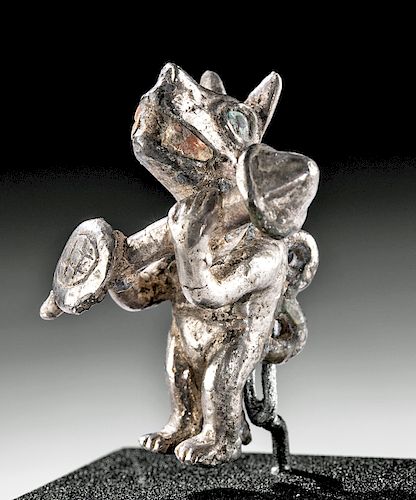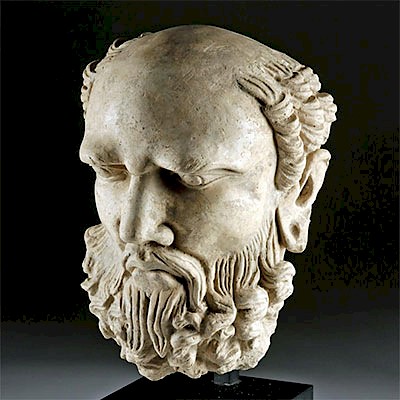Moche Silver, Turquoise & Lapis Jaguar Warrior Pendant
Lot 230
About Seller
Artemis Fine Arts
686 S Taylor Ave, Ste 106
Louisville, CO 80027
United States
Selling antiquities, ancient and ethnographic art online since 1993, Artemis Gallery specializes in Classical Antiquities (Egyptian, Greek, Roman, Near Eastern), Asian, Pre-Columbian, African / Tribal / Oceanographic art. Our extensive inventory includes pottery, stone, metal, wood, glass and textil...Read more
Estimate:
$4,000 - $6,000
Absentee vs Live bid
Two ways to bid:
- Leave a max absentee bid and the platform will bid on your behalf up to your maximum bid during the live auction.
- Bid live during the auction and your bids will be submitted real-time to the auctioneer.
Bid Increments
| Price | Bid Increment |
|---|---|
| $0 | $25 |
| $300 | $50 |
| $1,000 | $100 |
| $2,000 | $250 |
| $5,000 | $500 |
| $10,000 | $1,000 |
| $20,000 | $2,500 |
| $50,000 | $5,000 |
| $100,000 | $10,000 |
| $200,000 | $20,000 |
About Auction
By Artemis Fine Arts
Jan 16, 2020
Set Reminder
2020-01-16 10:00:00
2020-01-16 10:00:00
America/New_York
Bidsquare
Bidsquare : Ancient | Asian | Ethnographic
https://www.bidsquare.com/auctions/artemis-gallery/ancient-asian-ethnographic-4799
Featuring classical antiquities, ancient and ethnographic art from cultures encompassing the globe. Artemis Fine Arts info@artemisgallery.com
Featuring classical antiquities, ancient and ethnographic art from cultures encompassing the globe. Artemis Fine Arts info@artemisgallery.com
- Lot Description
Pre-Columbian, North Coast Peru, Moche, ca. 100 BCE to 100 CE. A very rare cast silver (94%) pendant depicting a standing jaguar warrior wielding a mace and shield. His jaguar mask is beautifully delineated with almond-shaped eyes inlayed with turquoise sclera and lapis lazuli pupils, an open mouth revealing teeth made from spondylus shell of red hues perhaps to signify his out-for-blood demeanor, raised alert ears, and a pronounced nose. A long tail hangs behind his body, and a pair of double loops for suspension and/or attachment protrude from the figure's back. During the mid-twentieth century, archaeologists labeled the period when the Moche came to power as the "Mastercraftsman Period" due to this culture's striking technological innovations in the arts. Indeed Moche artists are known for their fine metalwork as demonstrated by this example. Size: 1.375" H (3.5 cm); 3.125" H (7.9 cm) on included custom stand. Weight: 28.7 grams. Silver quality: 94%.
King of Beasts in the Pre-Columbian world, infamous for possessing high speed and massive strength, the jaguar was believed to dominate nature inspiring respect and awe throughout the ancient Americas. Jaguars were also associated with strength and leadership, whether in regard to spirituality or martial skill. Warriors, rulers, hunters, and shamans alike associated themselves with this King of Beasts, the largest and most powerful feline in the New World whom they viewed as their spirit companion and protector. Warfare and warriors are recurrent themes in Moche art, a strong testimony to the violence of Moche society, which was rife with intense combat and competition.
Provenance: ex-private Hirsch collection, New York City, New York, USA, collected from 1950-1970
All items legal to buy/sell under U.S. Statute covering cultural patrimony Code 2600, CHAPTER 14, and are guaranteed to be as described or your money back.
A Certificate of Authenticity will accompany all winning bids.
We ship worldwide and handle all shipping in-house for your convenience.
#150915Minute nicks to inlays. Otherwise intact and generally excellent save a few minor casting flaws. Pieces have developed a rich, lustrous patina over the centuries.Condition
- Shipping Info
-
All shipping is handled in-house for your convenience. Your invoice from Artemis Gallery will include shipping calculation instructions. If in doubt, please inquire BEFORE bidding for estimated shipping costs for individual items.
-
- Buyer's Premium



 EUR
EUR CAD
CAD AUD
AUD GBP
GBP MXN
MXN HKD
HKD CNY
CNY MYR
MYR SEK
SEK SGD
SGD CHF
CHF THB
THB














